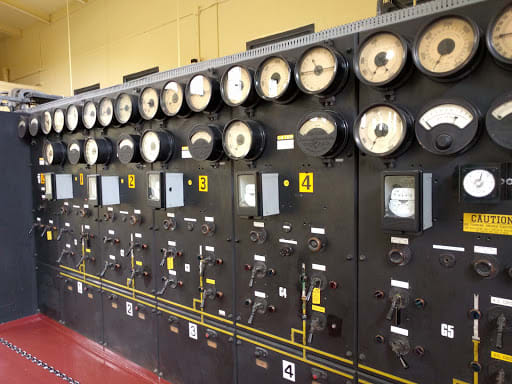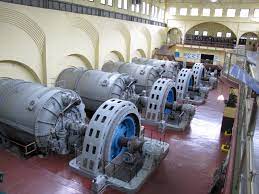It is difficult to answer your questions without knowing the type of generators used and what controls are available.
Back to basics with examples from conventional generators that I am familiar with.
That characteristics of a conventional generator.
This will be a conventional machine with an exciter and an Automatic Voltage Regulator.
Case #1. Islanded operation.
The power factor depends on the power factor of the load.
Increasing the excitation increases the terminal voltage.
Case #2. Distributed generation.
The voltage is controlled by the grid.
The VARs drawn by non-unity PF loads are supplied by the grid, and may or may not be shared equally amongst the various generators supporting the grid.
Increasing the excitation cannot overcome the grid voltage.* (Example; If a generator capacity is 0.01% of the capacity of the grid, then an increase in excitation that would cause a 10 Volt rise in an islanded machine will cause a voltage rise on the order of 10V x 0.0001 = 0.001 Volts change in grid voltage.)
Raising the excitation or EMF* increases the VARs delivered to the grid. *(Terminal voltage equals EMF minus internal voltage drops. The EMF is generally the open circuit voltage or unloaded voltage of the generator with no change in excitation.)
Note that the important value is the DIFFERENCE between the generator EMF and the grid voltage.
What is the importance of Power Factor?
Generators are rated in KVA, not KW. The popular press may report the capacity of a power plant in KW, but the unspoken qualification is that the KW capacity is stated at a given PF, most commonly PF = 0.8
A lower PF means greater KVA and with a PF below 0.8, the KW capacity of the generator may be curtailed.
Unrealized capacity means unrealized revenue.
Types of control.
Fixed excitation: *See anecdote below.
Any variation in grid voltage will cause a variation in PF. Higher grid voltage = less VARs exported.
Voltage control.
Similar to fixed excitation but worse. A rise in grid voltage will cause the AVR to reduce the excitation and even fewer VARs may be exported than with fixed excitation.
Power Factor control:
The generator operates at a fixed PF determined by the operator.
The tariff may set power factor operating limits and the operator may work between these limits to maximize output.
Special cases:
The grid control authority may have reasons to desire a specific power factor.
One case may be a heavy load on the end of a long distribution feeder.
One of the plants installs co-generation.
The grid authority may desire extra VARs to be supplied in order to overcome the voltage drop in the feeder caused by reactive current. While reactive current by itself does not consume real power, the I
2R losses caused by the reactive power do consume real power.
The grid authority may or may not pay for KVARHrs.
*[Anecdote alert]
Many years ago I had the opportunity to tour what may have been one of the last major hydro plants in North America under complete manual control.
The individual unite typically ran at either 10% output or 90% output.
At 10% output, the generators stayed warm and dry and remained synchronized to the grid, available for rapid dispatch.
While I was there, there was only myself and a lone operator in the station, the phone rang (POTS).
It was load control dispatch with the message;
"Take unit #4 to 90% output."
The operator turned a selector switch on the control panel.
A hydraulic valve opened and a large hydraulic cylinder controlling the water gates started to slowly extend.
The hydraulic pump was driven by a small Pelton Wheel.
As the output increase,the power factor dropped.
The operator then went to a rheostat control knob.
Turning that increased the current to the field of the exciter. This raised the excitation and the PF improved.
The operator went back to the hydraulic control switch and increased the water flow, while watching the dropping pF.
The operator reiterated these steps 4 or 5 times until the set was at 90% output.
Complete manual control according to voice commands or a Plain Old Telephone System. (POTS)
[/anecdote]
I hope that I have covered the basics enough that you may apply the knowledge to your individual situation and to the control equipment that you have available.
PS; CR has spent a career operating generating plants.
Respect any advice he may share with you.
In the event that there may be an apparent disagreement between CR and myself, it may be more a case of misunderstanding, or I may be learning something new.
--------------------
Ohm's law
Not just a good idea;
It's the LAW!

